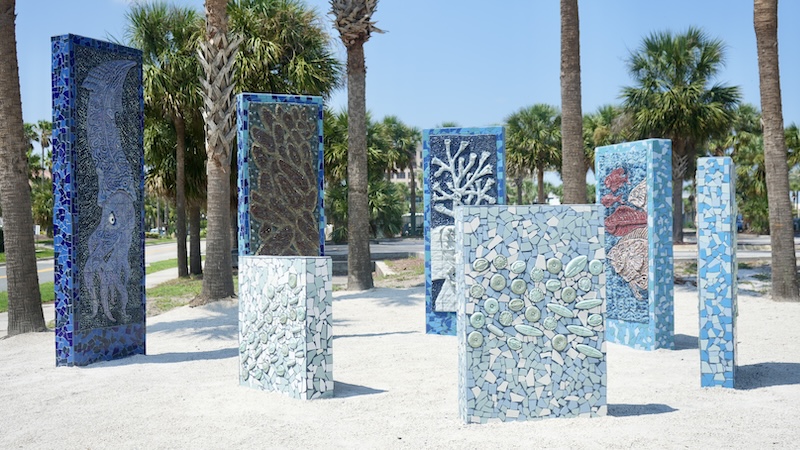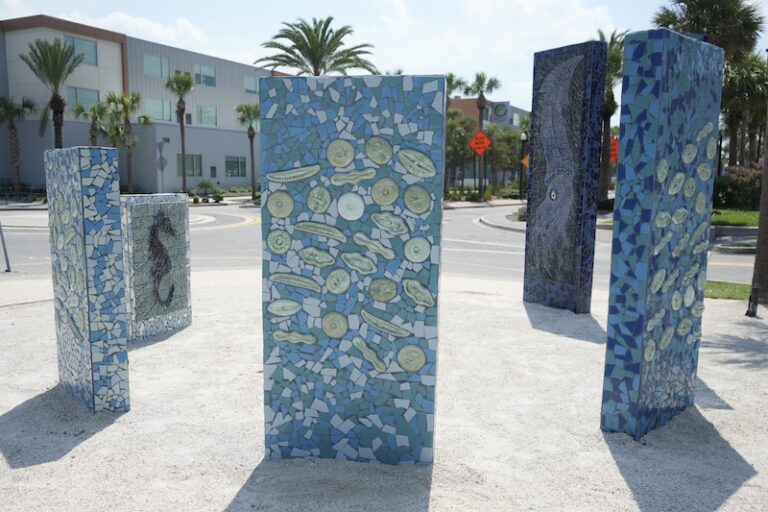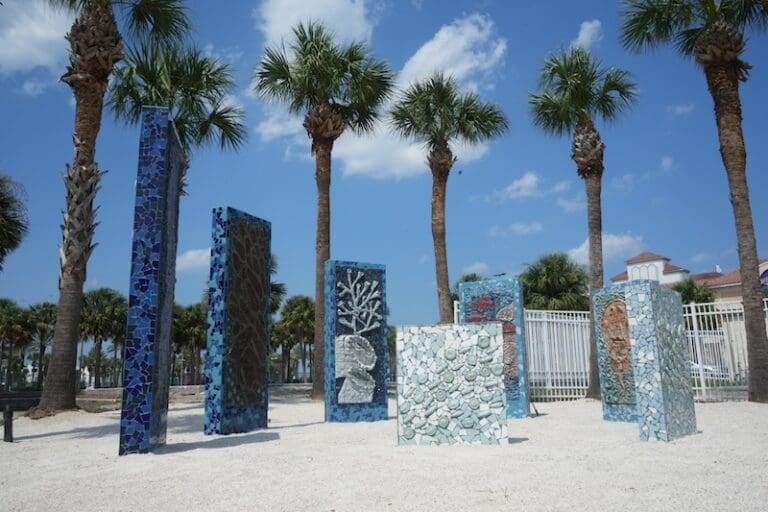Home » 2024 » Water Columns » Water Columns: About

“Water Columns” is a public art installation by Xavier Cortada, located in the heart of Jacksonville Beach, Florida. This vibrant project features seven columns that represent biodiversity from shore to sea, specifically highlighting the Blake Plateau — an ecological hotspot recently discovered off the U.S. coast. In collaboration with the Natural Resources Defense Council, this is the first public art piece designed to educate communities about the importance of the Blake Plateau.
This commission is strategically placed just a few blocks from the beach, at the intersection of Beach Drive and 2nd Street. It presents an exciting opportunity for Cortada to contribute to the vibrant local scenery with artwork that aims to inspire and engage both the community and its visitors.
The Installation
The installation, named “Water Columns,” features seven concrete columns of varying heights, from three feet to nine feet, arranged in a spiral form. Each column is 32 inches wide and 8 inches deep, clad in hand-carved, hand-painted ceramic tiles. They create a gradient of blue hues across the plaza, referencing the various zones emanating from the water’s edge.
Designed to reflect the unique coastal characteristics of Jacksonville Beach, the sculpture incorporates elements inspired by the beach’s natural beauty, such as waves and marine life. The vibrant ceramic tiles, with their intricate designs and coastal color palette, evoke a sense of place and capture the essence of the beach town.
The Columns
The columns are arranged in a spiral, with the backdrop made of broken ceramic flat tiles. As you move from one column to the next, the tiles gradually darken, symbolizing the deepening of the ocean and the transition from one marine zone to another.
The reverse side of each column features detailed ceramic depictions of diatoms, microscopic algae that are fundamental to the ocean’s food web and crucial for producing a significant portion of the oxygen we breathe. The diatoms serve as a unifying element across all columns, emphasizing the interconnectedness of marine life.
Environmental Impact
By choosing to create a sculptural installation that celebrates water, Cortada’s artwork becomes a platform to raise environmental awareness. It serves as a reminder of the vital importance of preserving and protecting the natural resources that make Jacksonville Beach so special. Through its design, symbolism, and possible interactive elements, the artwork serves as a reminder of the importance of preserving the coastal ecosystem. By engaging both locals and visitors alike, this public art installation can foster a sense of appreciation and responsibility towards the environment, encouraging individuals to become active participants in its protection and conservation.
Educational Component
The educational component of this public art project is presented by the Xavier Cortada Foundation. Special thanks to the Natural Resources Defense Council for their collaboration in developing the educational content for this project.
Shoreline | Sea Stars
This ceramic tile work represents the dynamic shoreline zone, featuring the resilient sea star. As a keystone predator, sea stars play a crucial role in maintaining the balance of shoreline ecosystems. Their populations are increasingly threatened by climate change and habitat loss, making their conservation vital.
Intertidal | Seahorse
Representing the intertidal zone, this piece highlights the delicate seahorse, a small fish that depends on seagrass beds for camouflage and survival. The survival of seahorses is closely tied to the health of seagrass ecosystems, which are under threat from climate change and human activities.
Nearshore | Horseshoe Crab
This column showcases the nearshore zone, featuring the ancient horseshoe crab, a species vital to both coastal ecosystems and medical research. Horseshoe crabs, known as “living fossils,” are essential to the marine food web and face challenges from habitat loss and overharvesting.
Continental Shelf | Fish
Depicting the continental shelf, this ceramic work celebrates the rich diversity of fish species in this zone. The continental shelf is a bustling marine habitat that supports a wide variety of life. Sustainable fishing practices are essential to preserving this critical ecosystem and its biodiversity.
Blake Plateau | Lophelia Corals
This piece represents the Blake Plateau, home to the world’s largest deep-sea coral habitat. The Lophelia corals found here form intricate and fragile ecosystems that are vital to marine biodiversity. Protecting these deep-sea environments is crucial as they face growing threats from climate change.
Blake Ridge | Chemosynthetic Mussels
Representing the Blake Ridge, this column highlights the unique chemosynthetic mussels that thrive in deep-sea methane seeps. These mussels, which depend on chemosynthesis rather than sunlight, create habitats that support a variety of marine life in the darkest depths of the ocean.
Blake Escarpment | Squid
This ceramic work illustrates the Blake Escarpment, focusing on the deep-sea squid, a key species in the ocean’s food web. Squid serve as both predator and prey in these deep waters, playing an essential role in maintaining the balance of marine ecosystems.



